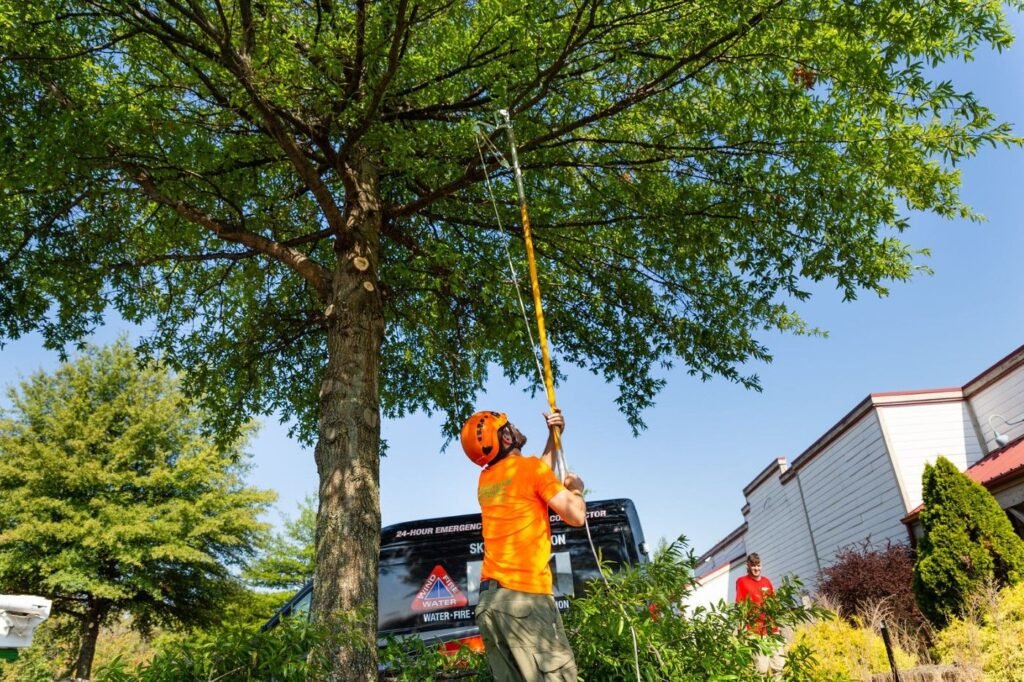Maximize Tree Health Professional Pruning Services Near You

Tree pruning is a horticultural practice that involves the selective removal of certain parts of a tree, such as branches or roots, to improve its health, appearance, or safety. By strategically cutting away unwanted or damaged parts, tree pruning helps maintain the overall well-being of trees, ensuring they continue to thrive in their environment.
Benefits Of Tree Pruning
Promotes Tree Health And Longevity
Regular pruning promotes the health and longevity of trees by removing diseased, damaged, or dead branches that can harbor pests or disease-causing pathogens. By eliminating these potential threats, pruning helps prevent the spread of infections and allows the tree to allocate more resources towards growth and development.
Improves Tree Structure And Aesthetics
Proper pruning can improve the overall structure and appearance of trees by removing branches that are crossing or rubbing against each other, as well as those that are growing in undesirable directions. By promoting a more balanced and symmetrical canopy, pruning enhances the visual appeal of trees and contributes to the overall beauty of the landscape.
Enhances Safety By Removing Dead Or Hazardous Branches
One of the most important benefits of tree pruning is the enhancement of safety around the tree. Dead or weakened branches pose a significant risk of falling, especially during storms or high winds, and can cause property damage or personal injury if they are not promptly removed. By identifying and removing these hazardous branches through pruning, property owners can minimize the risk of accidents and ensure the safety of their surroundings.
Encourages Fruit Production In Fruit-Bearing Trees
In fruit-bearing trees, pruning plays a crucial role in promoting healthy fruit production. By thinning out excess branches and removing dead or diseased wood, pruning allows more sunlight and air to reach the fruit-bearing parts of the tree, thereby improving pollination, fruit set, and quality. Additionally, pruning helps maintain the size and shape of the tree, making it easier to harvest fruit and manage pests and diseases.
How To Prune Trees Safely
Use Of Proper Tools And Equipment
Using the right tools and equipment is essential for safe and effective tree pruning. Sharp, clean pruning tools, such as hand pruners, loppers, and pruning saws, ensure clean cuts and minimize the risk of injury to both the tree and the pruner. It’s also important to wear appropriate safety gear, such as gloves, safety glasses, and a helmet, to protect against falling debris and sharp branches.
Safety Precautions For Climbing And Working At Heights
When pruning trees that require climbing or working at heights, it’s crucial to follow safety precautions to prevent accidents and injuries. This includes using a sturdy ladder or climbing harness, securing yourself with safety ropes or harnesses, and maintaining three points of contact at all times. It’s also important to be aware of potential hazards, such as power lines or uneven terrain, and take steps to mitigate risks.
Techniques For Making Clean Cuts To Promote Tree Healing
Making clean cuts is essential for promoting rapid healing and minimizing the risk of infection or disease in pruned trees. When pruning branches, it’s important to use proper cutting techniques, such as making angled cuts just outside the branch collar, to encourage the tree to form a strong callus and seal the wound effectively. Avoid leaving behind jagged or torn edges, as these can provide entry points for pests and pathogens.
Common Mistakes To Avoid
Over-Pruning Or Under-Pruning
One common mistake in tree pruning is over-pruning or under-pruning. Over-pruning, or excessive removal of branches, can weaken the tree and make it more susceptible to stress, disease, and insect infestations. On the other hand, under-pruning, or insufficient removal of branches, can lead to overcrowding, poor air circulation, and increased risk of branch failure. Finding the right balance between removing enough branches to achieve the desired results and preserving the tree’s health and structure is essential for successful pruning.
Pruning During The Wrong Season
Another common mistake is pruning trees during the wrong season. Pruning at the wrong time of year, such as during the active growing season or during periods of extreme cold or heat, can stress the tree and interfere with its natural growth cycles. It’s important to prune trees at the appropriate time based on their species and local climate conditions to minimize stress and promote healthy regrowth.
Cutting Too Close To The Trunk Or Leaving Stubs
Cutting too close to the trunk or leaving behind stubs when pruning branches can have negative consequences for the tree’s health and appearance. Cutting too close to the trunk can damage the tree’s bark and lead to decay, while leaving stubs can create entry points for pests and pathogens. To avoid these problems, it’s important to make clean cuts just outside the branch collar, where the branch meets the main stem, to promote proper healing and minimize the risk of complications.
Conclusion:
Tree pruning is a vital aspect of tree care that offers numerous benefits for both the tree and the surrounding environment. By understanding the principles of tree pruning and following proper techniques and safety precautions, property owners can promote the health, longevity, and beauty of their trees while minimizing the risk of accidents and injuries. Whether it’s removing dead or hazardous branches, shaping the canopy for aesthetics, or promoting fruit production in fruit-bearing trees, pruning plays a crucial role in maintaining the overall well-being.








